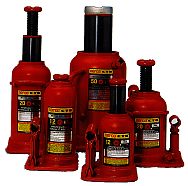|
|
|
|
|
BOTTLE/HAND JACK SPECS & PRICES
ANIMATION OF THE INSIDES OF A WORKING BOTTLE/HAND JACK
|
Bottle or hand jacks, came into wide spread popularity during the early
part of the 20th Century, paralleling the boom of the automobile
industry. They filled the immediate need of a small convenient
device requiring only one person to operate that could lift an
automobile off the ground for servicing - It quickly found
hundreds of other uses in the modern world, as well.
|

|
In addition, 1 1/2, 3, 8, 12 and even 20 ton capacity jacks are available in heights from 20 to 24 inches, popular in engine cherry picker/cranes and for special applications, however, the 8, 12 and 20 ton versions are quite expensive.
Bottle jacks and variations thereof appear in fields as diverse as medicine (for patient lifts, examing tables, hydraulic stretchers), plumbing (pipe benders), electrical (cable slicers), printing (paper cutters) warehousing (material handling), agriculture (equipment maintainance), construction (pushing, pulling, hoisting or lifting), food industry (from pallet jacks to pressing apple juice or sausages) metal shops (bending, cutting and fabricating) and in dozens of applications too numerous to mention.
Jacks, while traditionally used in an upright fashion with the ground as a base to lift a great weight in the air, are quite often mounted inside a framework to do a specific job such as compressing, as in a hydraulic press, or mounted on a verticle beam to push against a horizontal beam making a crane. An often overlooked characteristic of bottle jacks is that they can be turned sideways in order to push objects apart such as fence posts or a door frame warp by weather.
Japan exports the standard Masada models (sold by JET, OTC, POWER TEAM and SIMPLEX) and special made models originally designed by KYB and sold exclusively under the NORCO name in North America.
Several undeterminable brands of lower to middle quality are imported from China and Taiwan.
If you only need a jack once or twice a year as an emergency tool or for light duty occasional use - MAYBE a cheap Taiwan or Chinese jack will work for you, but they are notorious for leaking and failing just when you need it! (*See 2nd NOTE below...)
If you want a damn good tool at a fair price - buy the Japanese made jacks.
NOTE: In all fairness, because U.S. JACK does not actively market their products West of the Mississippi River (we're in Burbank California), we have not had our hands on one in years and simply DON'T KNOW if they are currently made as well as they used to be - So, we can't give an honest opinion on them, one way or another, sorry...
2nd NOTE:
A couple of years ago a Chinese manufacturer sent us an unsolicited, junk email extolling
their products. The email included this listing of their pricing:
FOB Shanghai2 TON..... USD$ 2.84
4 TON..... USD$ 3.89
6 TON..... USD$ 4.99
8 TON..... USD$ 6.21
10TON..... USD$ 7.26
12TON..... USD$ 8.32
16TON..... USD$ 9.37
20TON..... USD$ 10.74
30TON..... USD$ 15.26
50TON..... USD$ 34.74
|
In the last 20 years a new style of jack has come into
popularity in the heavy duty truck repair shops called an
Air/Hydraulic (usually pronounced 'air over hydraulic') jack.
What the manufacturers have done here, basically, is taken an
ordinary 20 ton bottle/hand jack, added an air activated
Porto-Power style pump (so, you don't have to bend down and pump
the jack to produce pressure) packaged it all up neatly in a
convenient little metal box with a couple of wheels and a nice
long handle and - BANG - every truck shop on the planet buys one!
Lifting capacities are between 20 and 22 tons (Norco actually
brings over a 44 ton model if you ever run into a railroad engine
with a flat tire...) with general lifting ranges starting at
about 10 inches and raising to 20 inches. All models require 80
to 160 PSI of compressed air.
NOTE: These jacks will NOT work manually, they MUST be powered by air. |
|
|
|
|
|
|
Consumer Phone Hours: 9:00 AM til 2:00 PM, Pacific Time, Monday - Friday,
.
OTTO SERVICE CO., PO BOX 1805, Sun Valley, California 91353-1805
United States of America

©2018 OTTO SERVICE